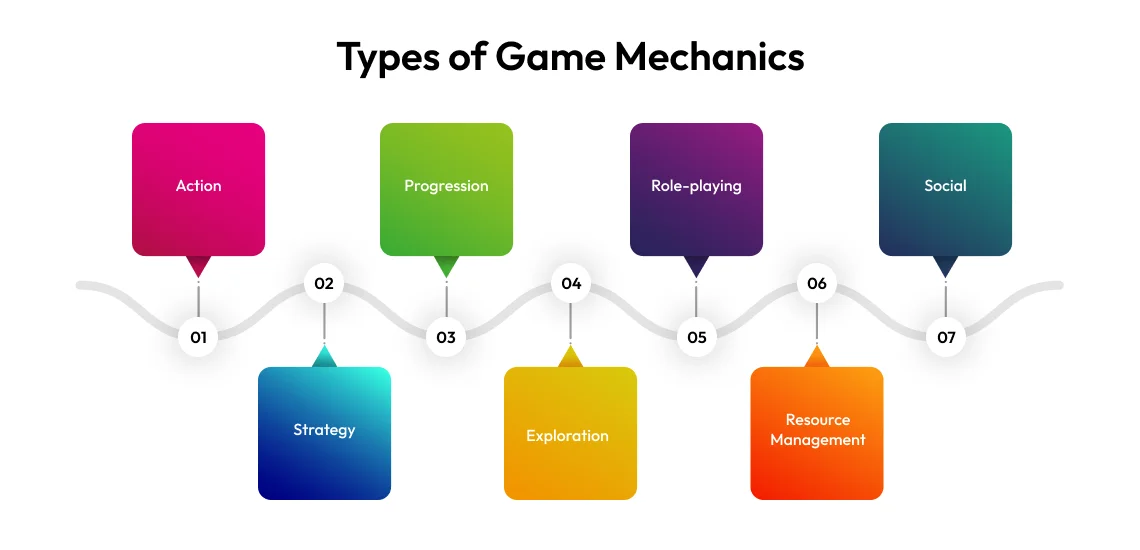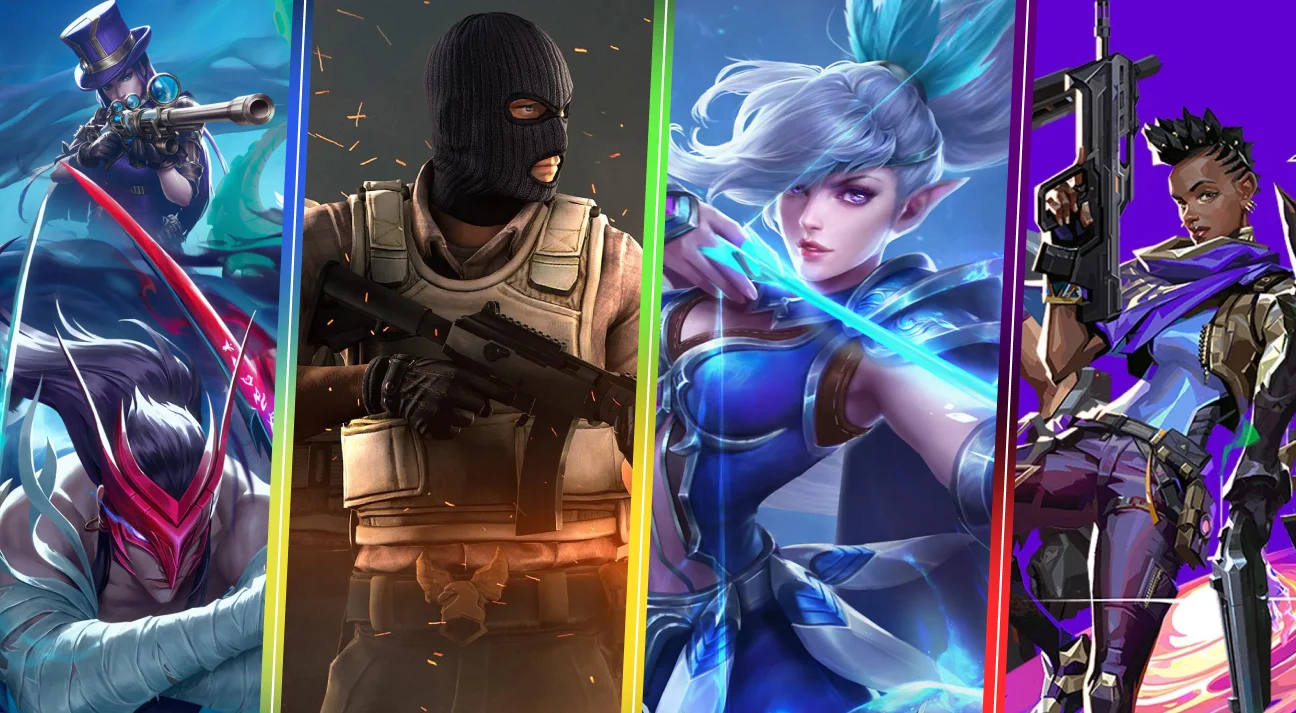
A Detailed Guide to Game Mechanics: Fundamentals, Types, Benefits, and more
Game mechanics play a crucial role in defining the game play experience, shaping the game flow, facilitating player agency, driving immersion, encouraging player retention, and more. If you’re just getting started with game mechanics for your game concept, this blog provides insights into the fundamentals of game mechanics, their types, benefits, common mistakes to avoid, and more.
When we look at iconic games that have created a hugely loyal fanbase, one key element that has contributed to their success is ‘Game Mechanics‘.
Take Super Mario Bros., for example. Its core mechanics involve running, jumping, navigating obstacles, collecting power-ups, and progressing through levels. These simple yet engaging mechanics have captivated players for decades.
On the other hand, GTA V offers a vastly different yet equally compelling set of mechanics. These include free-roaming in an open world, engaging in story missions and heists, vehicle combat, melee combat, character progression, and sophisticated AI behavior.
The impact of these well-designed mechanics is evident in the game’s commercial success. For example, data analysis shows that before its release, GTA V had 7 million pre-orders worldwide!
Looking ahead, GTA VI is set to break all pre-order records, driven by the incredible enthusiasm of its fan base. The trailer alone has gained an impressive 197 million views on YouTube and counting! It also became the most-liked video on YouTube in 24 hours with around 8.9 million likes and YouTube’s most-viewed trailer launch with 93 million views in 24 hours, cementing its place among the best video game trailers of all time.
This excitement is a testament to the powerful role that game mechanics play in the success of a game regardless of its simplicity or complexity.
It’s clear that effective game mechanics are at the heart of what makes these games iconic and beloved by millions.
So, let’s get to the bottom of what game mechanics are.
What Are Game Mechanics?
Game mechanics are the rules and systems that define how a game functions and how players interact with its elements. It includes character interactions, feedback systems, challenges, rewards, progression systems, resource management systems, and other aspects that make the game engaging and enjoyable.
Essentially, game mechanics answer all the ‘how’ questions of a game, including:
- How do players win?
- How does the player navigate the environment?
- How does the player interact with objects or characters?
- If there’s combat, how does it work?
- How can players unlock new abilities, assets, or areas?
- How do players progress in the game?
- How does the game reward the player for their actions?
- How do players earn, manage, and spend resources?
- How does the character or their abilities improve over time?
- How does the game communicate information to the player?
And so on.
Depending on factors such as game concept, goals, target audience, genre, theme, skill level, technical feasibility, and more, game mechanics can vary significantly from one game to another.
Types of Game Mechanics
According to different aspects of the game, game mechanics are categorized into various types so that game development company can adopt a structured approach to conceptualize, create, and analyze games, implementing the types of game mechanics that best fit.

Here are the most popular types of game mechanics:
1. Action Mechanics
Action mechanics involve fast-paced interactions within the game environment, requiring physical movement, reflexes, and skillful execution to progress or overcome challenges. These mechanics aim to provide engaging and responsive gameplay, rewarding players for their skill.
Key elements that contribute to action mechanics include various movements (like walking, running, jumping, climbing, swimming, or flying), combat systems (real-time, turn-based, or hybrid), and platforming mechanics (such as jumps and climbs).
Examples of action mechanics are shooting, fighting, hack and slash, stealth gameplay, vehicle control, physics-based interactions, attack dodging, and more.
2. Strategy Mechanics
Strategy mechanics require players to make informed decisions and evolve their strategies based on the progression of in-game situations to overcome challenges. It focuses on planning, problem-solving, and outsmarting opponents or the environment.
The core elements that contribute to defining strategy mechanics in a game are planning and decision-making, unit control and positioning, resource management, and more.
Some of the most adopted types of strategy mechanics include:
- Real-time strategy (RTS)
- Turn-based strategy (TBS)
- Tactical RPG (TRPG)
- 4X (explore, expand, exploit, exterminate) strategy
- Deck-building
- Puzzle strategy
- Fog of war and Scouting
- Tower defense
3. Progression Mechanics
These mechanics are designed to evoke a sense of advancement, achievement, and growth in players throughout their gameplay experience. Providing players with a rewarding game journey contributes to player retention and replayability.
The in-game elements that offer players a sense of progression in the game include character growth, unlocking new content (zones, items, challenges, modes, abilities, in-game status, skills, or storylines), setting milestones/goals, and more.
Some common progression mechanics that you can consider incorporating in your game are:
- Experience Points (XP)
- Leveling up
- Unlockable content
- Collectible content
- Leaderboards and achievements
- Skill trees
- Quests and objectives
- Progress bars
- Character customization
4. Exploration Mechanics
Just as the name suggests, exploration game mechanics are meant to encourage players to explore and discover the game world for hidden mysteries, secrets, and the unknown. These mechanics focus on creating a sense of adventure and reward players for their curiosity and exploration efforts.
Player progression in a game can be enhanced by including the following:
- Open world
- Hidden collectible content
- Environmental challenges
- Non-linear storytelling
- Deciphering a cryptic map
5. Role-playing Mechanics
The story narration is highly influenced by the persona of the characters that the player inhabits in the game. Role-playing mechanics enable players to experience the game environment from the character’s perspective, allowing them to shape the characters’ journey.
These mechanics create a power fantasy, story agency, character development, replayability, and more.
The in-game elements that define a game’s role-playing mechanics include:
- Character creation
- Character customization
- Skill progression
- Quests and objectives
- Combat systems
6. Resource Management Mechanics
Resource management significantly impacts various aspects of a game, such as game complexity, decision-making, reward satisfaction, and strategic thinking. It encourages players to consider how to acquire, allocate, and utilize limited resources and in-game assets to achieve their goals.
Here are the primary components that comprise resource management game mechanics:
- Resource acquisition
- Resource types
- Resource allocation
- Resource consumption
- Resource conversion
7. Social Mechanics
Apart from enhancing multiplayer gameplay, these mechanics are designed to foster interaction, cooperation, and competition among players, creating a sense of community, shared experiences, collaboration toward goals, and more.
Here are key components and examples of social mechanics:
- In-game communication tools
- Competitive gameplay: leaderboards, PvP (Player vs. Player) modes, and more
- Cooperative gameplay
- Guilds and teams
- Trading and sharing collectibles
- Social events
- In-game friend systems

Benefits of Game Mechanics
Each of the above types of game mechanics offers unique benefits to the gameplay experience of the players. Here are the benefits that incorporating balanced game mechanics offers:
Flow and Immersion
When a player engages with a game where challenges are balanced with their skill level, they become fully absorbed due to the induced sense of flow.
Intuitive controls, responsive character actions, a well-designed environment, and other interface elements contribute to the feeling of immersion that players experience while playing the game.
Motivation and Retention
The reward system in the game, along with meaningful challenges, motivates players to keep progressing and continue playing to level up, earn achievements, and unlock exciting content. This sense of accomplishment not only encourages player retention but also contributes to the long-term success of the game titles.
Balancing and Fairness
A game fails to capture the player’s enthusiasm for the game if the player either dominates the game or the game dominates over the player ‘unfairly.’ This often occurs when difficulty levels are not aligned with the skill level of the target audience.
Balanced and fair game mechanics ensure that players face challenges appropriate to their skill level, preventing frustration from excessive difficulty or boredom. This not only enhances player retention but also fosters healthy competition.
Improved User Experience (UX)
Game mechanics substantially contribute to the overall user experience of the game as they determine how players interact with the game.
When all elements involving game mechanics—including tutorials, feedback systems, customization, game balance, and more—are aligned with the target players, it leads to a smoother, more enjoyable experience, increasing player engagement.
Player Agency
Player agency refers to the level of control and influence players have over the game world and narrative. When the game offers players the freedom to make meaningful choices that translate into their own unique experiences within the game world, it enables them to foster a sense of agency and investment in the experience.
Replayability
The ultimate goal of any gaming studio is to cultivate a loyal fanbase as vast as that of iconic games like GTA. Replayability is crucial for fostering this loyalty. Varied player choices, dynamic gameplay, skill mastery, unlockable content, achievements, and more, compel players to keep coming back for one more game.
Emotional Connection
Effective game mechanics have the power to evoke a range of emotions, including excitement, satisfaction, empathy, and more. By crafting experiences that allow players to emotionally connect with characters, narratives, or game events, developers can significantly enhance player engagement and enrich the overall gaming experience.
Game Mechanic Mistakes To Avoid
Even though gaming studios understand the critical role game mechanics play in the success of games, they sometimes make mistakes that can cost them dearly, impacting their brand reputation.
Here are some common mistakes to avoid when creating game mechanics:
Unbalanced Difficulty
The difficulty curve is something that game makers need to take care of to ensure that the game is not frustratingly hard or mind-numbingly easy. In either scenario, players would end up losing interest and potentially abandoning the game. Game mechanics mistakes that can lead to unbalanced difficulty include:
- Little to no enemy/protagonist scaling concerning the player progression
- Player power creep
- Sudden spikes in difficulty after easier sections
- Insufficient feedback on player actions or outcomes
- Enemies or NPCs with inconsistent behaviors
- Inadequate balance of power-ups or abilities
Unrewarding Gameplay
Whether it’s leveling up, acquiring items, unlocking achievements or trophies, earning in-game currency, unlocking character customization rewards, and other such rewarding experience elements, they induce a sense of accomplishment, positive emotions, motivation to progress, and more.
However, if your game does not offer a well-designed and rewarding gameplay experience, it can lead to a lack of satisfaction, impact player retention, negative player experience, and more.
An unrewarding gaming experience can result from the following:
- Lack of meaningful milestones
- Repetitive or mundane tasks
- Poor implementation of the player progression system
- Unbalanced rewards implementation
Neglecting Play Testing
What if you have a great gaming idea, but once your game is published, players start encountering issues like bugs, glitches, crashes, server instability, and more? This could severely impact the game studio’s reputation as a developer and publisher.
This situation often arises when the game studio neglects to playtest the game mechanics before launch or during development. Therefore, a critical mistake to avoid is neglecting playtesting.
Even if the game studio conducts playtesting, here are common mistakes to avoid:
- Failing to test all aspects of gameplay mechanics
- Disregarding or undervaluing player feedback
- Conducting playtests with a narrow demographic or skill level
- Conducting playtests without clear objectives
- Not incorporating external playtesters or conducting open beta tests
Poor Feedback Systems
Players, upon interacting with the game, look for visual and auditory cues to understand the game mechanics and rules. Feedback creates a stronger connection between the player and the game. However, things can easily go south, leading to player frustration, confusion, reduced engagement, and a negative player experience.
Here are the game mechanics mistakes that lead to a poor feedback system:
- Slow or delayed responses to the player’s actions
- Unclear feedback cues
- Providing too much or too little information
- Responses that do not reward players appropriately
- Tutorials with unclear or immediate feedback
Overcomplication
The fulfilling experience that players seek from a game often hinges on well-balanced complexity in its mechanics. However, at times, game studios may inadvertently overcomplicate things in their pursuit of creating engaging, intuitive, and rewarding gameplay experiences through complex mechanics.
This can result in player frustration, disengagement, decreased game appeal, and potential impacts on future sales.
Overcomplication in the game mechanics typically arises from:
- Including too many mechanics
- Lengthy or overly detailed tutorials
- Poorly integrated new mechanics
By avoiding these game mechanics mistakes, game development studios can create an enjoyable experience for players, laying a strong foundation for developing more successful games.
Experience the Power of Game Mechanics with 300Mind
At 300Mind, we are dedicated to crafting exceptional games that resonate with players. As a leading game development studio, we specialize in a comprehensive range of services including Unity game development, Unreal Engine projects, AR/VR experiences, mobile games, and more. Our team is committed to understanding your unique game vision and delivering bespoke game mechanics that enhance user engagement.
With a creative approach and deep industry expertise, we tailor game mechanics to align perfectly with your project goals. Whether you’re aiming for immersive narratives, innovative gameplay, or cutting-edge technology integrations, we’re here to exceed your expectations.
Contact us today to discuss your game mechanics needs. Let’s collaborate and create game mechanics that drive an unforgettable gaming experience!
FAQs on Game Mechanics
Since game mechanics can make or break a player’s experience, choosing the right ones is crucial for your game’s success. Here are some key considerations such as defining core actions and rewards, establishing an appropriate difficulty curve, understanding your target audience’s preferences, ensuring technical feasibility and more.
Game mechanics involve the rules, player interaction, game system, and more that enable you to define core gameplay mechanics. Meanwhile, fluff, also known as flavor, includes aesthetic details, characters, story, narrative, and more that enhance the game’s immersive experience.
Game mechanics define the core gameplay aspects (actions, fundamental rules, and challenges) that address how to play the game, while game features encompass broader elements such as character customization, level design, player modes (solo or multiplayer), and more.








